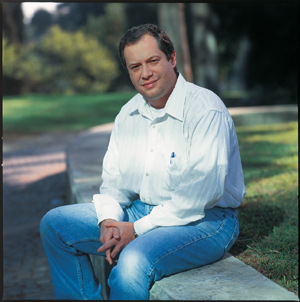Are you a journalist? Please sign up here for our press releases
Subscribe to our monthly newsletter:

Lucio Frydman devotes much of his time to one of the oldest traditions of humankind - making tools and using them to explore the world that surrounds us. But things have changed quite a bit since early blade-shaping, fire-making and glass-blowing attempts. “The goal is to craft ever-sensitive recording methods for peering into the heart of matter,” says Frydman, a professor in the Institute’s Chemical Physics Department.
The tool he is working to perfect is called nuclear magnetic resonance (NMR), which, since its development in the 1940s, has proven invaluable to studying the structure of molecules, designing new drugs and even exploring the human brain (see box).
The key to NMR is magnetism. All matter is made up of atoms, and each atom contains a nucleus. When exposed to electromagnetic radiation, nuclei “get excited” - they start spinning, creating their own electromagnetic sounds. The nucleus of each type of atom emits a sound that is entirely unique. The challenge facing NMR scientists is to study the dispersion patterns of the sound waves produced by the excited molecules - in other words, to work backward from the resulting “nuclear symphony” to reconstruct a precise three-dimensional picture of the molecule.
It’s not an easy task. To date, scientists wishing to obtain a full NMR picture of complex molecules needed to perform numerous measurements: hundreds or thousands of one-dimensional scans, which could only be performed one after the other. These scans were then combined to create a unified three-dimensional picture. While a single scan took a fraction of a second, the multidimensional procedures leading to the overall picture of the molecule could last several hours or even days.
Now Frydman and his team have developed an approach called ultrafast multidimensional NMR that significantly expedites the analysis of the electromagnetic sounds produced, making it possible to acquire complete multidimensional NMR spectra within a fraction of a second.
Their approach, described in the Proceedings of the National Academy of Sciences (PNAS), USA, “slices up” the molecular sample into numerous thin layers and then simultaneously performs all the measurements required on every one of these slices. The protocol then integrates these measurements according to their precise location, generating an image that amounts to a full multidimensional spectrum from the entire sample.
Thanks to the speed with which the new method collects the data, scientists will now be able to observe rapid changes taking place in molecules, such as the folding of proteins. In a sense, the method amounts to a transition from taking NMR “stills” to making NMR “movies.”
Frydman’s team is applying the techniques they’ve developed to study a variety of molecular structures and their potential interactions with their surroundings. One of their projects examines how nucleic acids and other biological molecules bind to metal ions (metals play vital roles in a range of systems, including serving as catalysts, which speed up reactions or enable them to occur). Additional projects aim to facilitate the efficient use of NMR in pharmaceutical and biochemical studies.
The team’s approach should make it possible to examine molecular and biological systems with a much higher time resolution than was previously possible, yielding detailed insights into molecular-level interactions. These, in turn, might advance the design of new drugs as well as industrial catalysts and novel materials.
Contributing to this research were Dr. Adonis Lupulescu of the Chemical Physics Department and Dr. Tali Scherf of Chemical Services at the Weizmann Institute of Science.
Prof. Frydman’s research is supported by the Fritz Haber Center for Physical Chemistry; the Henri Gutwirth Fund for Research; the estate of Ilse Katz, Switzerland; the Philip M. Klutznick Fund for Research; the Minerva Stiftung Gesellschaft fuer die Forschung m.b.H.; and the Abraham and Sonia Rochlin Foundation.
Research using nuclear magnetic resonance dates back to the 1940s, when Felix Bloch of Stanford University and Harvard’s Edward Purcell first applied NMR to examine solids and liquids, earning themselves the 1952 Nobel Prize in Physics. Weizmann Institute scientists Shlomo Alexander and Shaul Meiboom built one of the world’s first high-resolution NMR spectrometers in the early 1950s. They and other Institute scientists later developed an NMR approach for measuring the behavior of molecules in crystals and solutions. Since then NMR and its daughter technique, MRI, have evolved into what is arguably the most commonly used analytical and diagnostic tool in scientific research, spanning the fields of medicine, structural biology, pharmaceutical chemistry, condensed matter physics and earth sciences.
Argentinean-born Prof. Frydman received a Ph.D. in chemistry from the University of Buenos Aires. Following a postdoctoral period at the University of California, Berkeley he joined the faculty of the University of Chicago, where after seven years he became a full professor. He and his family settled in Rehovot, Israel, in 2001, when he joined the Institute’s Chemical Physics Department.
And why choose NMR research? “This field is unique in the way it combines quantum mechanical principles with instrumental and computational challenges,” says Frydman. “Moreover, its importance as a diagnostic tool in a variety of scientific fields means that there’s always a new question just waiting to be explored.”